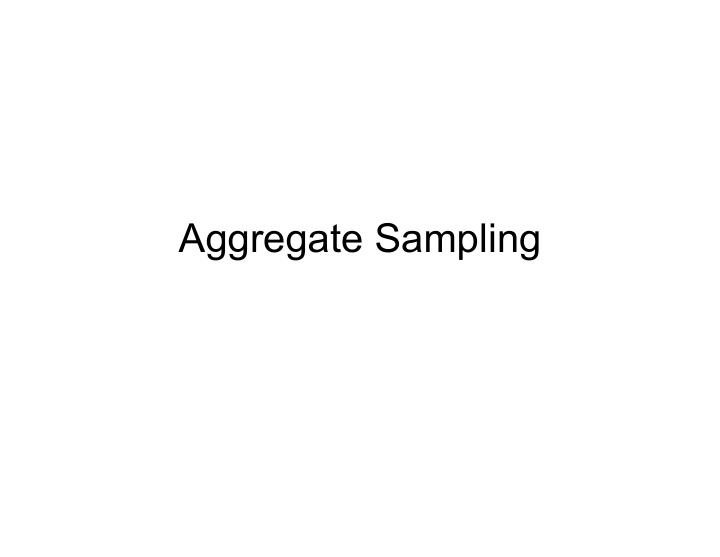



Aggregate Sampling
Aggregate Stockpiles CIVL 3137 2
Stockpile Segregation CIVL 3137 3
Stockpile Segregation CIVL 3137 4
Aggregate Sampling Aggregate sampling is the process of taking a sample of aggregate that is truly representative of the nature and condition of the aggregate in the stockpile. The size of the field sample is large to ensure that it is truly representative. Special effort must be made to ensure that the sample is not skewed by the effects of segregation. The required size of the field sample and the sampling procedures are specified in ASTM D75. CIVL 3137 5
CIVL 3137 6
Aggregate Sampling Obtaining unbiased field samples from stockpiles is notoriously difficult, but it can be done with care and attention to detail. A bucket loader makes the process easier and assures a more representative sample. The loader can quickly extract material from a number of locations and elevations in the pile then combine and mix the portions in a smaller pile for direct sampling. CIVL 3137 7
Aggregate Sampling If you need to sample a stockpile manually, start at the top and take at least three samples from the top, middle and bottom of the pile. Remove and discard the surface material and collect the samples from the underlying material with a shovel or scoop. Pushing a board into the uphill side of the sampling point prevents additional material from falling into the sampling area. CIVL 3137 8
Aggregate Sampling CIVL 3137 9
How much do you need? Field Sample Size for Fine and Coarse Aggregate (from ASTM D75) CIVL 3137 10
Nominal Aggregate Sizes 3 / 8 " 1½" ¾" 4 8 16 30 50 100 200 100 Nominal Maximum = 3/8″ Percent Passing 80 60 90% of the sample lies between the 3/8" and No. 16 sieves. The 40 rest is not really representative. 20 Nominal Minimum = #16 0 100 10 1 0.1 0.01 Opening Size (mm) CIVL 3137 11
More Aggregate Terms Maximum aggregate size The smallest standard sieve through which 100% of the material passes. Nominal maximum aggregate size The largest sieve that retains some of the aggregate but generally not more than 10 percent by weight. CIVL 3137 12
Superpave Definitions Nominal maximum aggregate size One standard sieve larger than the first sieve to retain more than 10 percent of the material. Maximum aggregate size One standard sieve larger than the nominal maximum size. CIVL 3137 13
More Aggregate Terms Nominal minimum aggregate size The largest sieve that passes some of the aggregate but generally not more than 10 percent by weight. CIVL 3137 14
CIVL 3137 15
Minimum Sample Size Sample Size for Sieve Analysis of Fine and Coarse Aggregate (from ASTM C136) 300 300 CIVL 3137 16
Sample Reduction The goal of sample reduction is to reduce the large field sample to a size that is convenient for use in laboratory tests in such a way that the test sample is still representative of the field sample, and thus of the total aggregate supply. For the test sample to be truly representative, sample reduction must be accomplished with a minimum of operator interaction. CIVL 3137 17
CIVL 3137 18
Method 1 – Quartering (on an uneven surface) CIVL 3137 19
Why Discard Opposite Corners? A 1 A 2 A 1 + A 3 A 2 + A 4 A 4 A 3 CIVL 3137 20
Method 1 – Quartering (on a flat, level surface) CIVL 3137 21
Method 2 – Riffle Splitter CIVL 3137 22
Method 2 – Riffle Splitter CIVL 3137 23
Example A new barge load of aggregate has arrived at the plant and been deposited in a stockpile by a conveyor belt. You need a sample on which to perform a gradation analysis. If the nominal maximum aggregate size is 1" what size field sample do you need and how will you reduce it to the size required by the gradation test? CIVL 3137 24
Example Field Sample Size for Fine and Coarse Aggregate (from ASTM D75) CIVL 3137 25
Example Sample Size for Sieve Analysis of Fine and Coarse Aggregate (from ASTM C136) 300 300 CIVL 3137 26
Example Split again Split once Field sample 12.5 kg 50 kg 25 kg CIVL 3137 27
Recommend
More recommend